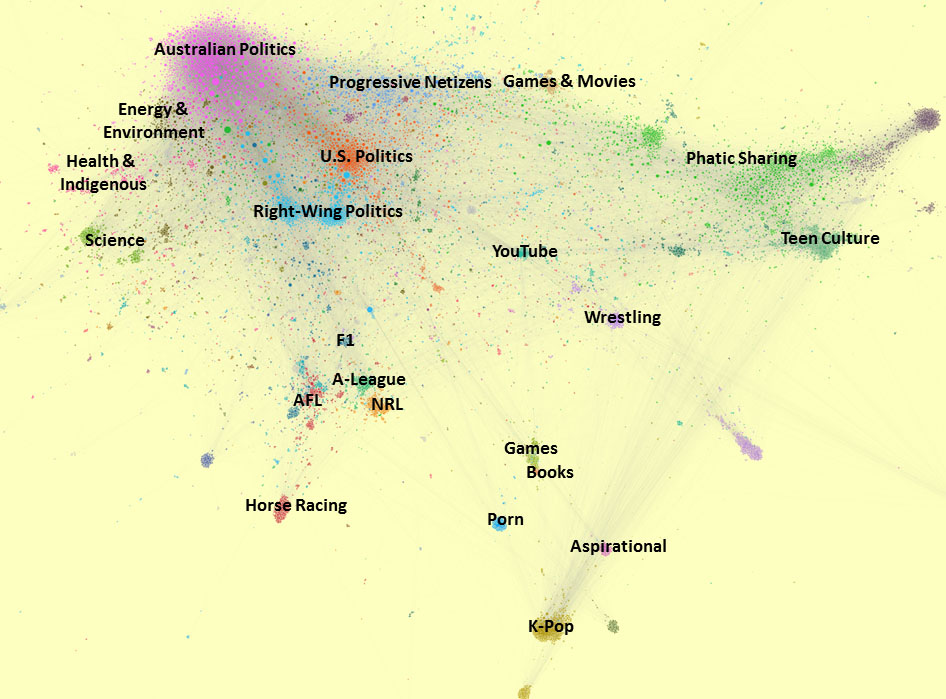
Twitter is, for many of us, synonymous with Trump pronouncements, outrage campaigns and reality TV commentary but a large cluster of Australia's 3.7 million Twitter users quietly tweet away using the platform as it was originally intended – a 140-character conversation space.
- 24 hour snapshot of Australia's 3.7million Twitter users' tweets
- One of first studies to describe Twitter use by ordinary Australians
- Large group of tweeters most prolific and active
- This group not interested in visibility of major hashtags
A snapshot of 24 hours of Australians' Twitter use on 22 March 2017 (when tweets were 140 characters) which captured 1,294,569 tweets from 176,737 unique accounts was analysed by QUT's Digital Media Research Centre, with some surprising results.
Professor Axel Bruns, who conducted the research with Dr Brenda Moon, said much research had been done on the loudest voices on Twitter but not on the everyday use by ordinary tweeters.
"It is critical we understand how Twitter and other social media platforms are used by all users because as calls for social media regulation grow we do not want to see legislation that causes unintended 'collateral damage'," Professor Bruns said.
"We focussed on hashtags, @mentions, retweets and URLs in the sample and analysed their ebb and flow during the 24-hour period.
"We found a distinct group of accounts out of the spotlight of major hashtags that was the most active and prolific over the course of the day.

"Only 5 per cent of their tweets were hashtagged, indicating they were not interested in the wide reach for their tweets that a well-known hashtag such as #auspol or #mkr might bring.
"About half of this group's tweets were retweets and/or contained URLs, indicating sharing of personal updates and observations to followers. A quarter of the tweets were original and contained neither @mentions nor retweets.
"This group focussed on a wide variety of issues, away from any consistent obsession with single issues or controversial topics."
Dr Moon said overall, fewer than 25 per cent of all tweets posted during the day contained hashtags, indicating that the prominence often given to hashtag-centric studies ignored 75 per cent of ordinary tweeting activity.
"This imbalance between hashtagged and non-hashtagged tweets is unlikely to be due to unfamiliarity with hashtags – instead, it seems many users choose not to use them," Dr Moon said.
"However, overall, hashtags occurred in 28 per cent of retweets and 26 per cent of original tweets, more often than @mentions found in only 20 percent of tweets overall.
"@mentions were thus more frequent in the small-scale conversations away from the enhanced visibility of hashtags."

Professor Bruns said the Australian Twittersphere began to heat up at 4am when bots and semi-automated accounts took flight, posting spam and algorithmically generated content.
"At 6am the dawn chorus began and the picture changed dramatically – from now till late evening political hashtags were prominent, including the well-known #auspol and #qt (for parliamentary question time).
"Overall, tweeting never dropped below 28,000 per hour. Daytime activity was higher in the morning and evening, but driven more by existing accounts posting more than with new accounts joining the conversation.
"Retweeting activity was interesting in that it peaked after 6am to 48.5 per cent and declined steadily through the day to pick up late in the evening – this may relate to news reading and sharing as users come online in the morning and retweet news to their followers, and again in the evening as they engage with the latest news from Europe and North America."
Professor Bruns said the study sketched out previously overlooked but potentially widespread user practices.
"This sort of activity we call phatic sharing – its function is similar to small talk among friends and acquaintances. People involved in this practice are using Twitter essentially as a place to hang out and shoot the breeze. It is emblematic of the mundane, everyday experiences of ordinary users, and it has not been sufficiently recognised in previous research.
"Individually, these phatic sharers rarely generate significant impact but collectively they represent a leading use of Twitter."
"One Day in the Life of a National Twittersphere" was published in Nordicom Review.






